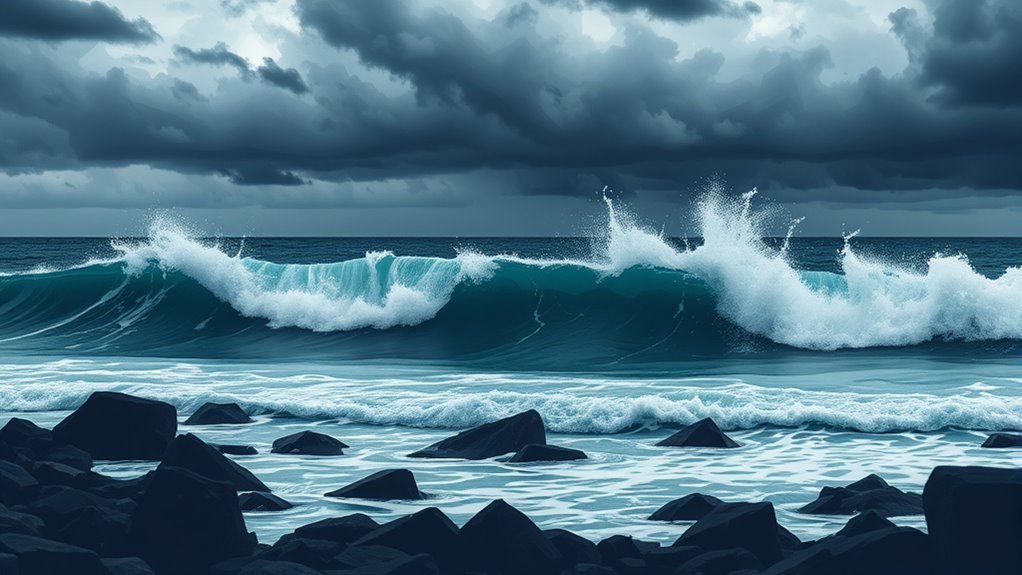Old weather lore and myths can greatly misinterpret squall phenomena. They often suggest squalls are harmless or predictable events. These misconceptions stem from ancient observations and cultural sayings that fail to capture the complexity of squalls. In reality, squalls can be intense and last longer than commonly believed. Understanding the formation of squalls, including the impact of temperature, pressure, and geography, is essential. This knowledge helps inform better preparedness strategies and safety measures. More perspectives await.
Main Points
- Historical weather lore often inaccurately associates squalls solely with thunderstorms, overlooking their occurrence in various weather patterns.
- Myths suggest squalls are predictable events, leading to dangerous underestimations of their suddenness and severity.
- Many believe squalls only affect maritime environments, ignoring their potential impact on land and urban areas.
- The perception that squalls are harmless can result in inadequate preparedness and response during severe conditions.
- Cultural sayings about squalls often perpetuate outdated beliefs, hindering public understanding and accurate weather education.
The Historical Roots of Weather Lore
Although weather lore has evolved over centuries, its historical roots can be traced back to ancient civilizations that relied on keen observations of nature. Societies such as the Babylonians and Greeks meticulously recorded weather patterns, associating celestial events with atmospheric changes. For instance, the Greeks noted the correlation between the position of constellations and seasonal shifts, leading to early agricultural practices.
In various cultures, oral traditions emerged, conveying wisdom about weather phenomena. Indigenous peoples, for example, interpreted animal behavior and plant growth as indicators of impending weather changes. This collective knowledge not only aided survival but also nurtured a sense of connection to the environment.
As these observations were passed down through generations, they transformed into proverbs and sayings. Consequently, weather lore became a fundamental part of cultural identity, reflecting humanity's enduring quest to understand and predict the natural world.
Common Myths Surrounding Squalls

Many myths surrounding squalls persist, often leading to misconceptions about their nature and impact. One prevalent belief is that squalls are exclusively associated with thunderstorms; nevertheless, they can occur in various weather conditions, not just during storms.
Another common myth is that squalls are predictable, giving people a false sense of security. In reality, their sudden onset can catch even seasoned meteorologists off guard.
Additionally, some individuals believe that squalls only affect maritime environments, overlooking their potential impact on land, where they can still produce dangerous winds and rapid temperature changes.
Moreover, the notion that squalls are harmless has led to underestimations of their severity, contributing to accidents and injuries.
These myths underscore the importance of understanding squalls accurately to mitigate risks and improve safety for those in affected areas. Recognizing the realities of squall phenomena can help individuals make informed decisions during adverse weather events.
Understanding Squall Formation
Understanding the conditions that lead to squall formation is essential for grasping their unpredictable nature. Squalls typically arise from dynamic atmospheric interactions, where varying air masses collide. These phenomena often occur in conjunction with cold fronts or when warm, moist air is rapidly lifted over cooler air, creating instability. The resulting turbulence can lead to sudden, intense winds and precipitation, which characterize squall events.
Factors such as geography, including topography and proximity to bodies of water, also play a critical role in squall development. Areas with notable elevation changes can improve wind patterns, contributing to the formation of squalls.
Additionally, the presence of weather systems, such as low-pressure areas, can further exacerbate these conditions. Understanding these variables helps meteorologists predict squall occurrences more accurately, thereby mitigating their impacts on communities and improving preparedness for sudden weather changes.
The Role of Temperature and Pressure in Squalls

How do temperature and pressure interact to influence squall formation? The dynamics between varying temperatures and atmospheric pressure play a significant role in the development of squalls. When warm, moist air rises rapidly, it creates a drop in pressure, often leading to unstable conditions. This instability can trigger sudden wind shifts and intense precipitation characteristic of squalls.
- Warm air ascends, leading to low pressure zones that enable squall formation.
- Rapid temperature changes can create strong wind gusts and abrupt weather shifts.
- High-pressure systems can act as barriers, forcing warm air to rise and intensifying squall conditions.
Understanding these interactions helps to demystify squall phenomena, revealing that it is not just folklore but rather a consequence of fundamental atmospheric principles.
Recognizing the role of temperature and pressure allows for a more accurate interpretation of weather events, moving beyond outdated myths and assumptions.
The Impact of Geography on Squall Development
Although squalls can occur in various geographic locations, their development is markedly influenced by the surrounding terrain and topography. In coastal regions, warm ocean waters can interact with cooler air to create conditions conducive to squall formation.
Similarly, mountainous areas can improve squall activity as air is forced to rise over lifted terrain, leading to rapid cooling and potential instability.
Moreover, valleys can channel winds, increasing their speed and intensity, which may further contribute to squall development. Urban environments may also play a role; heat generated by buildings can create localized updrafts, influencing weather patterns.
Conversely, flat plains may experience squalls driven primarily by frontal systems without notable topographical interference.
In the end, the geographic context shapes not only the occurrence of squalls but also their characteristics, making the study of terrain essential for understanding these weather phenomena.
Debunking Misconceptions About Squall Duration and Intensity
Misconceptions about squalls often cloud public understanding of their duration and intensity.
Factors such as atmospheric conditions and geographical influences play vital roles in shaping these storms.
Common Myths Explained
While many believe that squalls are brief and inconsequential weather events, a closer examination reveals that their duration and intensity can vary considerably. This misunderstanding can lead to inadequate preparation for those affected by squalls.
Common myths include:
- Squalls last only a few minutes: In reality, some squalls can persist for over an hour, impacting visibility and safety.
- All squalls are equally intense: Intensity can differ widely, with some squalls producing severe winds and heavy precipitation, while others may be mild.
- Squalls occur only during storms: Squalls can develop unexpectedly in otherwise calm weather, catching individuals off guard.
Squall Duration Factors
Understanding the factors that influence squall duration and intensity is essential for accurate weather forecasting and public safety. Squalls can vary greatly in length, typically lasting from a few minutes to several hours, depending on atmospheric conditions.
Key factors include wind shear, humidity levels, and temperature gradients, which determine how quickly a squall can develop and dissipate. Additionally, the geography of an area, such as mountains or bodies of water, can modify local weather patterns and influence squall behavior.
Misconceptions often arise from the assumption that squalls are uniform in duration; nonetheless, their variability is a result of complex interactions among meteorological elements. Recognizing these factors aids in better understanding and predicting squall events.
Intensity Misunderstandings
Squall events are often surrounded by misunderstandings regarding their intensity and duration. Many believe these weather phenomena are uniformly severe or long-lasting, leading to miscalculations in preparedness and response.
In reality, squalls can vary markedly, both in how intensely they manifest and how long they last.
Common misconceptions include:
- Uniform Intensity: Not all squalls produce high winds; some may be relatively mild yet still cause localized hazards.
- Extended Duration: Squalls often occur rapidly, usually lasting only a few minutes, contrary to the belief that they persist for longer periods.
- Predictable Patterns: Squalls can develop unpredictably, making it difficult to forecast their intensity based solely on historical data.
Understanding these nuances is essential for effective weather preparedness.
The Importance of Accurate Weather Education
Accurate weather education plays an essential role in nurturing informed communities, as individuals equipped with reliable information can make better decisions in response to changing conditions. Understanding weather phenomena, including squalls, allows people to distinguish between myths and scientific facts, leading to improved safety during severe weather events.
When communities are educated about the dynamics of weather patterns, they are less likely to succumb to panic or misinformation.
Furthermore, accurate weather education cultivates resilience, enabling individuals to prepare effectively for adverse conditions. This preparation can minimize property damage and reduce the risk of injury.
Schools, local governments, and meteorological organizations should prioritize accessible weather education programs to encourage awareness and understanding. By dispelling outdated lore and myths, communities can build a culture of informed decision-making, ultimately advancing public safety and encouraging proactive measures in the face of unpredictable weather.
Common Questions
What Are the Signs of an Approaching Squall?
Signs of an approaching squall include rapidly darkening skies, sudden shifts in wind direction, a noticeable drop in temperature, and the appearance of ominous clouds. These indicators often precede intense rainfall and strong gusts of wind.
How Do Squalls Differ From Thunderstorms?
Squalls are brief, intense wind events often accompanied by rain, while thunderstorms include lightning, thunder, and can last longer, featuring severe weather elements. Understanding these differences aids in better preparation for changing weather conditions.
Can Squalls Occur Without Rain?
Squalls can indeed occur without rain. These sudden, strong gusts of wind may arise from changes in atmospheric pressure or temperature, leading to turbulent conditions without accompanying precipitation, demonstrating their distinct characteristics from typical storm systems.
What Safety Measures Should I Take During a Squall?
During a squall, individuals should seek shelter indoors, secure loose objects, and avoid driving if possible. Staying informed through weather alerts improves safety, while remaining calm can help in effectively responding to sudden changes.
Are Squalls More Common in Certain Seasons?
Squalls are indeed more common in specific seasons, particularly during spring and summer. These seasons are marked by unstable atmospheric conditions, which contribute to the development of intense, short-lived wind and rain events known as squalls.

